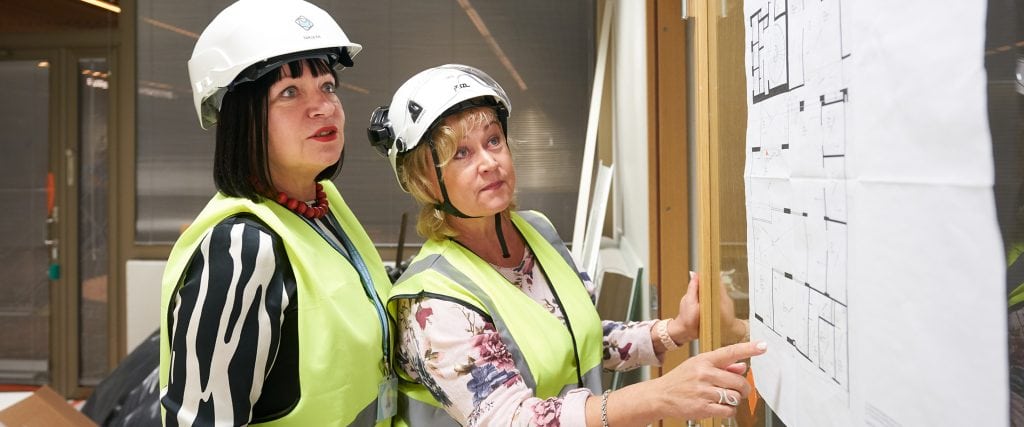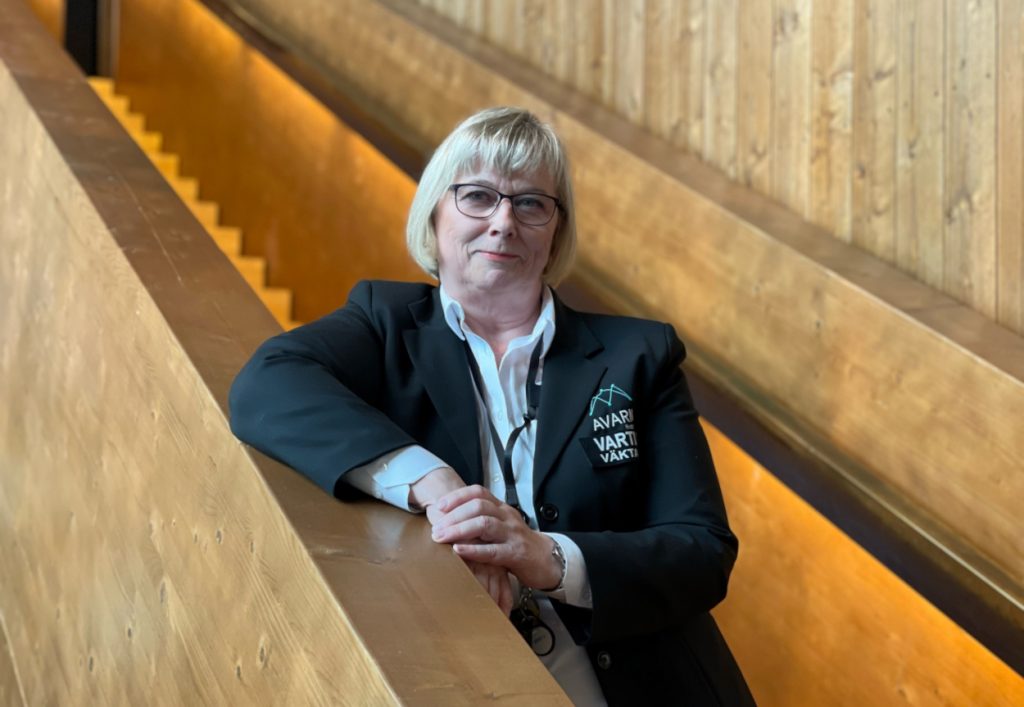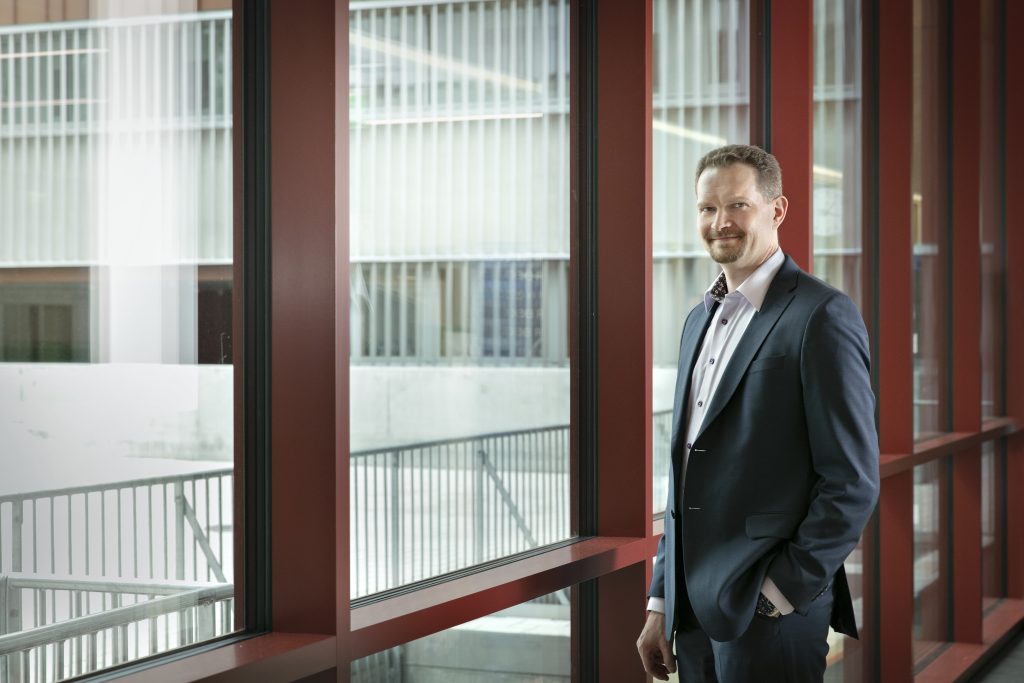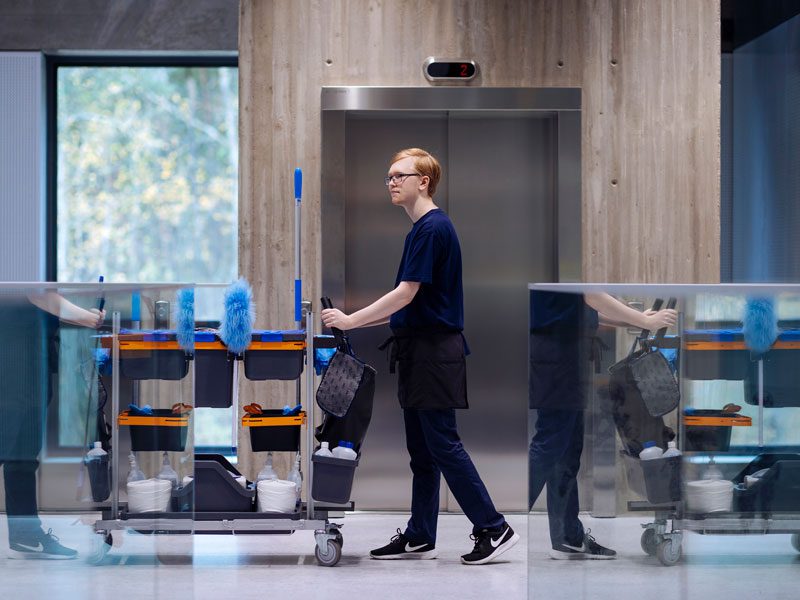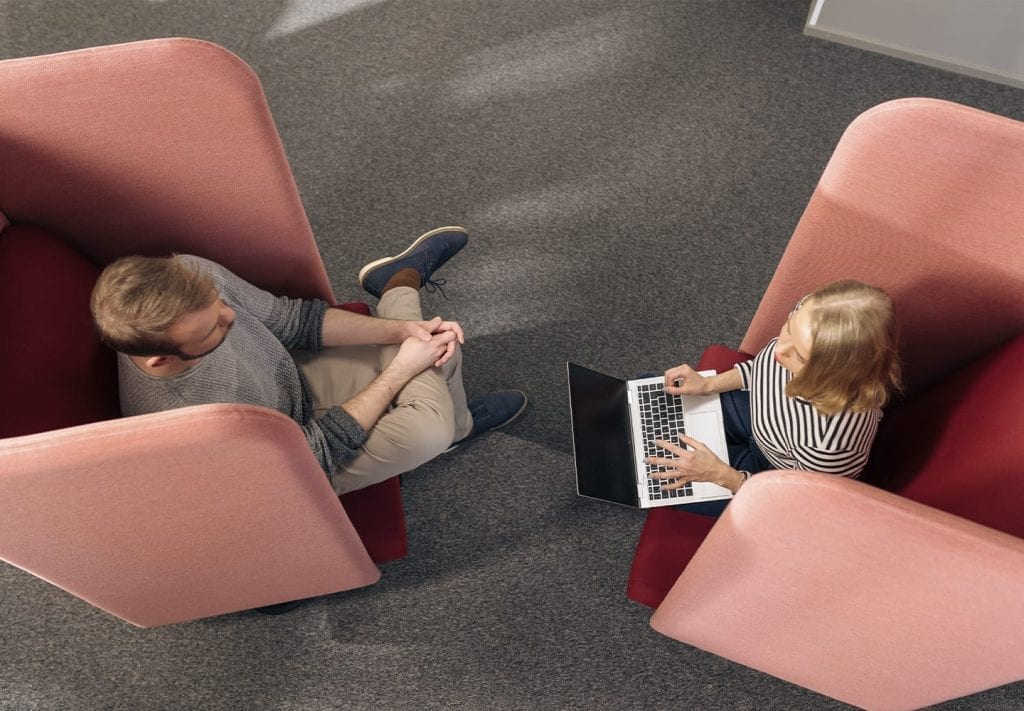Light streams in through large windows. It is reflected from oak-framed window elements that are waiting in neat piles in the lobby to be taken away. The Turku offices of the National Land Survey (NLS) will soon be many times more spacious than before: workers are busy removing walls to clear the outdated cubicles out of the way of a new and fresh activity-based environment to be completed in autumn 2018.
“When the modernisation project has been completed, our staff can return from temporary offices to a comfortable, functional and modern workplace. Our space efficiency will also be better and costs lower. In other words, the project is aligned with the Government Premises Strategy and our own facilities strategy, too,” says Tarja Ek, Facilities Manager at NLS.
The view from the top floors of the government office building across Itsenäisyydenaukio Square and the Aura River flowing below is stunning. The windows on the other side face the lush Urheilupuisto Park.
In the future, the view will be easier to take in when the one and two-person rooms along long corridors are gone.
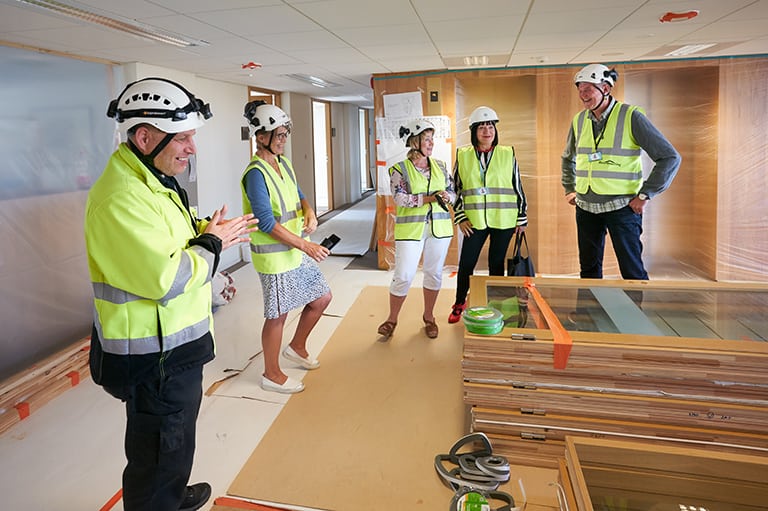
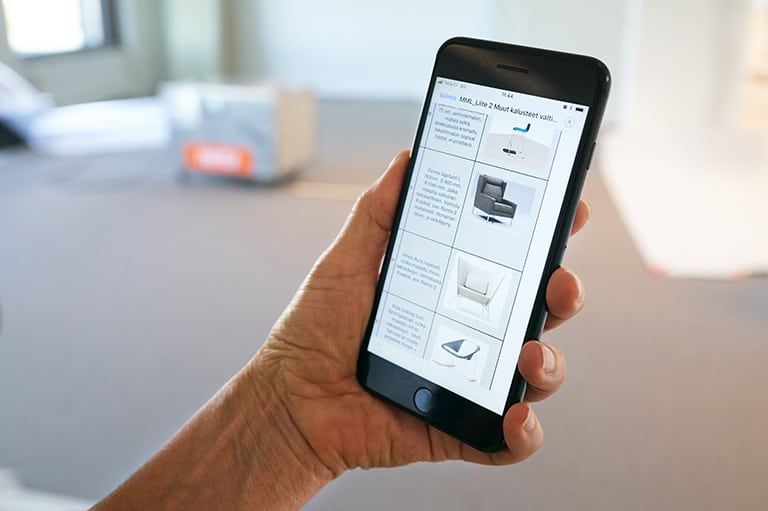
Tommi Tirkkonen (left) from Turun Rakennustiimi, who is in charge of site supervision, Sinikka Selänne, Senior Advisor at Senate, and Merja Hakamäki, Register secretary, Tarja Ek, Facilities Manager and Jarmo Kemppainen, Surveyor, all from NLS, checking on the progress of the modernisation project (top).
In the activity-based model, interior design plays a key role. Senate has created a common brand for the government office building and will select and tender all furniture. “The colours of the furniture may vary but otherwise every agency uses the same collection of furniture. That simplifies modernisation: the common appearance will remain no matter who is using the premises,” says Sinikka Selänne (bottom).
More space, more freshness
Senate Properties owns the 1967 government building that was designed by the architects Risto-Veikko Luukkonen and Helmer Stenroos. Known for its imposing copper exterior, the building is centrally located next door to Turku City Theatre and Wäinö Aaltonen Museum.
The NLS staff used to occupy roughly half of the seventh floor and the entire eighth floor. After the modernisation project has been completed in October, all staff, excluding customer service, will work on the seventh floor in a brand-new activity-based office.
According to Tarja Ek, concentrating activity on a single floor will not mean that there will be less space. In fact, the opposite will be true.
“With fewer walls, the facilities will be more light, spacious and fresh”.
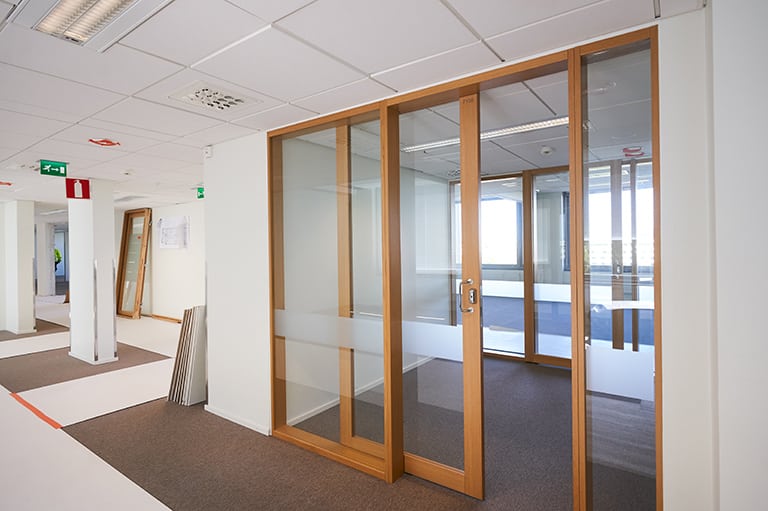
The walls have had to go as Senate modernises the seventh floor of the government building into a modern and well-lit activity-based environment for the National Land Survey. When the building was completely overhauled in 2013, a new partition wall system was installed where the partitions between rooms are easy to remove, which is why the current project got off to such a speedy and tidy start.
The NLS has 40 offices from Mariehamn to Ivalo. In Turku, it has 119 employees.
Tarja Ek says that the NLS started to implement its own facilities strategy in 2014 and set high targets for improving its space efficiency. The initial efficiency was 36 square metres per employee and the figure is now 21.7 and should be 15 by 2020.
“We designed the first activity-based environments in Oulu, Hämeenlinna and Pori. Turku is the eighth location that was turned into a modern activity-based office. It has already become apparent that the decision was the right one and the old work-room model does not support the modern way of working. Despite some initial opposition to the change, surveys show that satisfaction with the work environment has increased and collaboration has got better.”
Ek says that good premises meet people’s different needs and styles of working.
“Space is needed for interactive work, quiet work, teamwork, meeting with colleagues and relaxing. In activity-based environments the premises are a tool just like a computer. You can work in different places according to what you are doing. Studies show that activity-based environments are beneficial to knowledge work and they enable their users to choose what kind of space and soundscape they want to work in at any given time.”
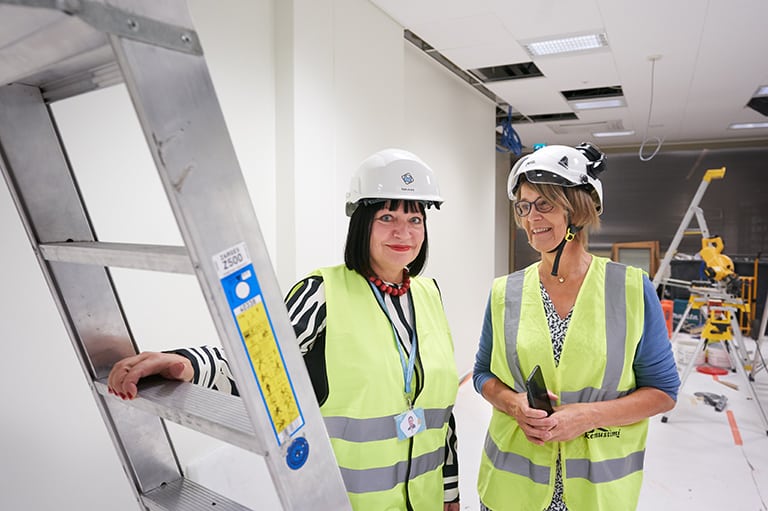
Tarja Ek from NLS and Sinikka Selänne from Senate Properties are happy that, thanks to their good co-operation, the change could be made quickly. In Turku, NLS’s space efficiency was 19.4 square metres per employee before the change and now, in the activity-based environment, it is 12.7 square metres. Contact between NLS’s different offices takes place mainly with Skype and Lync and the new activity-based office supports electronic work.
Senate has a key role in the change
Sinikka Selänne, Special Advisor at Senate Properties, says that the reason for the modernisation project that is underway in the National Land Survey premises was the Local Register Office of Southwest Finland’s acute need for new premises.
“In late 2017, worrying messages started coming from the register office: its staff had been suffering from indoor air issues for some time in the premises they occupied, which were leased from a private property company. The office wanted out and we at Senate helped them. We used our own lawyers to help them to cancel their lease agreement.”
Under Selänne’s direction, Senate organised temporary space at three locations in a few weeks: the Government office building, the Kela offices on Eerikinkatu and the Heikkilä barracks in Turku.
“You could say they fled their old offices,” she says.
It was clear that the register office could not operate long in three different offices. Sinikka Selänne thought that the tenants of the Government office building and their facilities’ needs could be the answer.
”The NLS has ample space and on a couple of occasions we had already taken their excess space and given it to other agencies. Since I knew that their goal was to gradually move into an activity-based office, I made a draft proposal to them and calculated that the entire staff could fit on the seventh floor with the same space efficiency as at the Southwest Finland ELY Centre and TE services that occupied the same building. Since I also knew that the NLS’s own resources were occupied with other things, I suggested that Senate could take more responsibility for implementing the change.”
Following negotiations, the National Land Survey thought it was a great idea and Selänne discovered that the register office would fit well on the eighth floor where there would be unoccupied space. In addition to taking care of the modernisation and acquiring new furniture, Senate agreed to help NLS with moving into temporary facilities, furnishing them, calculating the costs of the removal and taking an inventory of and moving furniture.
“The pieces fit together perfectly. You could say the National Land Survey saved the register office.”
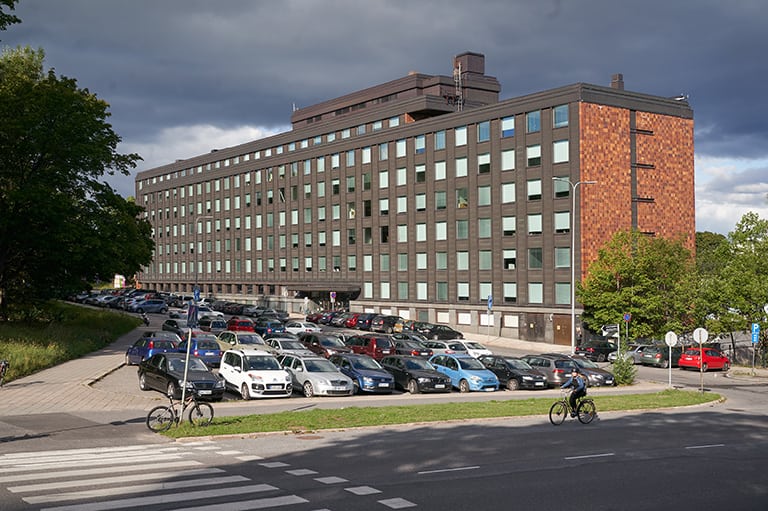
Known for its antiqued copper exterior, the Government office building is located in an impressive spot by the Aura River. It was completely refurbished into a modern office building in 2013.
A flexible office building
Sinikka Selänne and Tarja Ek agree that without mutual, open and flexible co-operation where all parties are heard, the project could not have been completed in such a short time.
“Planning of the activity-based environment was started in collaboration in January 2018. Senate’s management talks a lot about how such projects are time consuming and should be completed more quickly. I decided that if that’s the case, we’ll see how quickly we can do it,” says Selänne.
She adds that the NLS staff has taken the rapid progress of the project well.
“There has been some confusion, of course, because people were told not to expect that anything would happen for while and then suddenly the conversion into an activity-based office was moving ahead full steam. After all, they were working in relatively new offices, even if in conventional rooms.”
In 2009, Senate started work on the complete modernisation of the Government office building: it was overhauled both inside and outside in three stages, with only the concrete frame remaining of the old building. By 2013, it had been completely refurbished into a modern office building. Selänne says that it was already obvious then that the change would continue.
“We were far-sighted at the time. The building was designed to be not only healthy and safe but with easy modification in mind. Its new ventilation system was decentralised so that it could easily be modified and made more efficient. All partitions separating office rooms were system walls, which has turned out to be a goldmine for subsequent alterations: the walls are simple to detach and raise. Thanks to the light structure, we have been able to carry out fast and low-cost modernisation projects.”
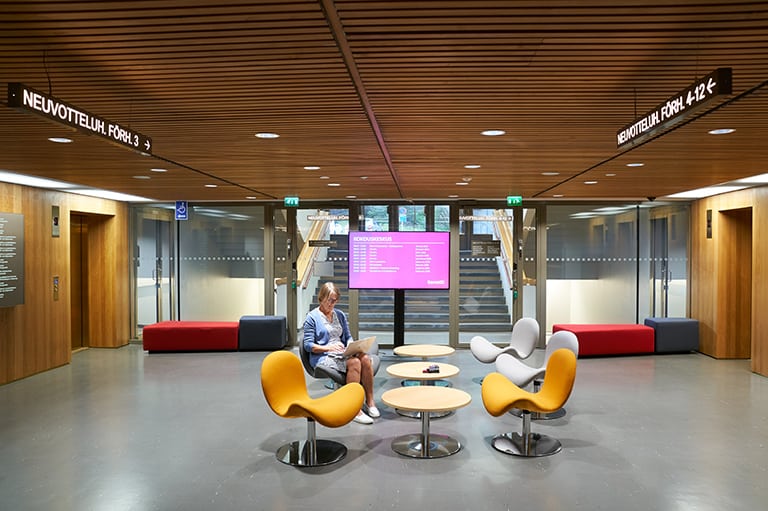
Before the modernisation was completed in 2013, almost 400 people worked in the Government office building. “We calculated at the time that there is enough space for a thousand people. That seemed a lot but we are approaching it now,” Sinikka Selänne says.
Workshops play a key role in change management
Tarja Ek explains that NLS staff has been working in two locations during the project: on the eighth floor of the office building, where room was provided for as much of the staff as was possible, and in temporary offices at the Heikkilä barracks, in the same building temporarily occupied by the register office.
“In change management it is vital that the staff is openly informed of the plans, that they are heard and kept informed of the project’s progress.”
NLS organised its first staff information event in January 2018. In March, employees took part in workshops under Pertti Siekkinen, who is Senate’s specialist in change management, to discuss the opportunities of the new work environment and to engage in free debate.
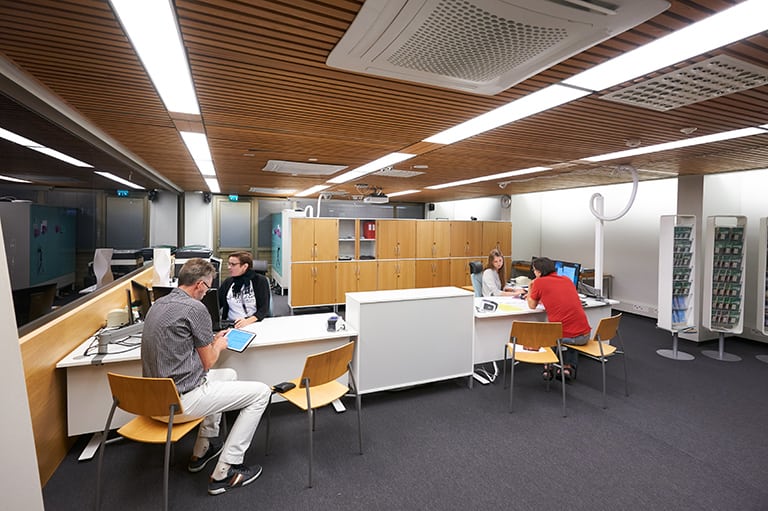
The NLS customer service was the first to move from the temporary premises shown in the photo to the new offices in September.
“We went over the basics on a general level: what an activity-based office is and how it will change the way we work. In September we organised two more process-specific workshops in which staff learn in practice what the new activity-based environment will mean for them and their work. This has turned out to be a very important stage and has helped staff to prepare for the transition to the new environment and to learn a new way of working,” says Ek.
She finds it important that the NLS has been able to improve its work environment in collaboration with Senate in the long term and through fruitful cooperation.
“Our customer relationship is more like a partnership and the people at Senate know our concept like the back of their hand. Riitta Sirèn, Account Manager at Senate, has played a key role in our cooperation and we work very closely with her on a national level. Here in Turku, cooperation with Sinikka Selänne, Tarja Hietamäki, who is Construction Project Manager, and Petri Nurmio, the Property Manager, has been very efficient. They hear us and if there is a problem, they react quickly.”
In the next part of the series, we will find out how the National Land Survey staff prepares for the move to the new premises and how they feel about the change.

